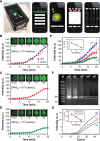Lab-on-a-Drone: Toward Pinpoint Deployment of Smartphone-Enabled Nucleic Acid-Based Diagnostics for Mobile Health Care
- PMID: 26898247
- PMCID: PMC4857158
- DOI: 10.1021/acs.analchem.5b04153
Lab-on-a-Drone: Toward Pinpoint Deployment of Smartphone-Enabled Nucleic Acid-Based Diagnostics for Mobile Health Care
Abstract
We introduce a portable biochemical analysis platform for rapid field deployment of nucleic acid-based diagnostics using consumer-class quadcopter drones. This approach exploits the ability to isothermally perform the polymerase chain reaction (PCR) with a single heater, enabling the system to be operated using standard 5 V USB sources that power mobile devices (via battery, solar, or hand crank action). Time-resolved fluorescence detection and quantification is achieved using a smartphone camera and integrated image analysis app. Standard sample preparation is enabled by leveraging the drone's motors as centrifuges via 3D printed snap-on attachments. These advancements make it possible to build a complete DNA/RNA analysis system at a cost of ∼$50 ($US). Our instrument is rugged and versatile, enabling pinpoint deployment of sophisticated diagnostics to distributed field sites. This capability is demonstrated by successful in-flight replication of Staphylococcus aureus and λ-phage DNA targets in under 20 min. The ability to perform rapid in-flight assays with smartphone connectivity eliminates delays between sample collection and analysis so that test results can be delivered in minutes, suggesting new possibilities for drone-based systems to function in broader and more sophisticated roles beyond cargo transport and imaging.
Conflict of interest statement
The authors declare no competing financial interest.
Figures




Similar articles
-
Smartphone-Enabled Detection Strategies for Portable PCR-Based Diagnostics.Methods Mol Biol. 2017;1571:251-266. doi: 10.1007/978-1-4939-6848-0_16. Methods Mol Biol. 2017. PMID: 28281261
-
Smartphone-Based Droplet Digital LAMP Device with Rapid Nucleic Acid Isolation for Highly Sensitive Point-of-Care Detection.Anal Chem. 2020 Jan 21;92(2):2258-2265. doi: 10.1021/acs.analchem.9b04967. Epub 2019 Dec 30. Anal Chem. 2020. PMID: 31841633
-
A portable nucleic acid detection system using natural convection combined with a smartphone.Biosens Bioelectron. 2019 Jun 1;134:68-75. doi: 10.1016/j.bios.2019.03.050. Epub 2019 Mar 29. Biosens Bioelectron. 2019. PMID: 30954928
-
Enabling miniaturised personalised diagnostics: from lab-on-a-chip to lab-in-a-drop.Lab Chip. 2017 Sep 26;17(19):3200-3220. doi: 10.1039/c7lc00587c. Lab Chip. 2017. PMID: 28850136 Review.
-
Portable microfluidic and smartphone-based devices for monitoring of cardiovascular diseases at the point of care.Biotechnol Adv. 2016 May-Jun;34(3):305-20. doi: 10.1016/j.biotechadv.2016.02.008. Epub 2016 Feb 18. Biotechnol Adv. 2016. PMID: 26898179 Review.
Cited by
-
Unprecedented opportunities for a transformational change.J Neonatal Nurs. 2021 Jun;27(3):157-164. doi: 10.1016/j.jnn.2021.04.001. Epub 2021 Apr 30. J Neonatal Nurs. 2021. PMID: 33967584 Free PMC article. No abstract available.
-
Advances in Plant Disease Detection and Monitoring: From Traditional Assays to In-Field Diagnostics.Sensors (Basel). 2021 Mar 18;21(6):2129. doi: 10.3390/s21062129. Sensors (Basel). 2021. PMID: 33803614 Free PMC article. Review.
-
Human-Device Interaction in the Life Science Laboratory.Adv Biochem Eng Biotechnol. 2022;182:83-113. doi: 10.1007/10_2021_183. Adv Biochem Eng Biotechnol. 2022. PMID: 35091814
-
Smart technologies driven approaches to tackle COVID-19 pandemic: a review.3 Biotech. 2021 Feb;11(2):50. doi: 10.1007/s13205-020-02581-y. Epub 2021 Jan 11. 3 Biotech. 2021. PMID: 33457174 Free PMC article. Review.
-
ABE-VIEW: Android Interface for Wireless Data Acquisition and Control.Sensors (Basel). 2018 Aug 13;18(8):2647. doi: 10.3390/s18082647. Sensors (Basel). 2018. PMID: 30104474 Free PMC article.
References
Publication types
MeSH terms
Substances
Grants and funding
LinkOut - more resources
Full Text Sources
Other Literature Sources
Medical
Molecular Biology Databases
Miscellaneous

